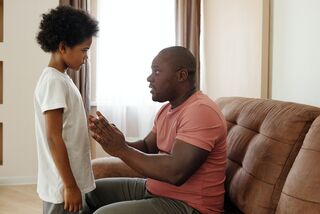Trauma
How to Talk With Your Kids About Traumatic Events
Five reasons why parents should, and four ways to do it.
Posted July 6, 2022 Reviewed by Vanessa Lancaster
Key points
- Because stories of tragic events bombard kids, it is crucial to talk with them and help them process their emotions.
- Parents may want to initiate conversations with their children, particularly because kids often hear misinformation from peers.
- Asking your kids what they already know can help you have age-appropriate conversations about difficult topics.

In 2022, amidst a global pandemic, the United States has been the site of an array of horrific and tragic events–from the mass shootings in Uvalde, Buffalo, and Highland Park, to the discovery of 46 dead Latinx migrants in San Antonio.
Television channels and social media accounts have been bombarded with thoughts and prayers for the victims and survivors of these tragedies, often accompanied by images of people experiencing the worst event of their lives.
Moreover, with recent legal attacks on women’s health and trans health, as well as political movements to silence or actively oppress people of historically marginalized groups, parents may wonder if they should talk with their children about these difficult events and the topics they involve (e.g., death, hate, violence).
If they do decide to initiate these conversations, they may not know what to say; they may question what would be most effective, and they may even worry that such conversations can be harmful or damaging.
From my training as a counseling psychologist and as a researcher who studies trauma, I am certain that parents and other adults should talk with children. If they want their kids to understand the happenings of the world while also having room to ask questions, multiple conversations can assist their children with their knowledge, insight, empathy, grief, and healing. With that, I humbly offer some reasons why parents should talk with their kids and some tips on how they could do it.
1. Kids have questions. As much as parents think they are protecting kids by not talking about issues related to violence (e.g., mass shootings, terrorism, police brutality, hate crimes) or oppression (e.g., racism, LGBTQ rights, women’s rights, disabled rights), young people absorb information that parents may not even be aware of.
They listen to adult conversations and consume all sorts of media (e.g., news, social media, television programming), which results in both opinions being formulated and questions needing clarity. Many children will be uncomfortable asking adults for clarification on their questions or concerns, which is why adults need to initiate these conversations.
2. Kids talk with each other. Children of all ages teach others what they’ve learned from their own homes or media consumption. Younger children teach their peers new words or concepts (both good and bad). Meanwhile, older kids introduce peers to opinions, jokes, and other content. When you don’t discuss traumatic news events with your children, there’s a possibility other kids will provide your kids with misinformation or controversial perspectives.
Peers' versions or interpretations of these events may also instill an array of emotions that your children aren’t prepared to handle–including fear, anger, and grief. So, if you don’t talk to your kids, other kids will, and they may tell them things you might not want them to hear.
3. Kids communicate unresolved emotions through their behaviors. When children feel angry, scared, sad, helpless, anxious, or traumatized, they may “act out” through their behaviors. Younger children may engage in temper tantrums or perpetuate violent acts (e.g., hitting, kicking, spitting) towards their peers, siblings, teachers, or parents.
Older kids may engage in self-harming behaviors (e.g., cutting or experimenting with alcohol, nicotine, or other substances); depression-related behaviors (e.g., crying, sleep disturbances, changes in eating); or other harmful interpersonal behaviors (e.g., bullying, physical violence, inappropriate or risky sexual behaviors).
4. Kids can experience collective trauma. Collective trauma is the notion that a group of people may develop negative psychological symptoms after a member of that community suffers from an act of violence, even if they did not directly encounter the act or know the victim or survivor personally. Symptoms may include difficulty concentrating or functioning, loss of interest in life activities, or feeling unsafe or insecure in their everyday lives.
Racial trauma is a collective trauma experienced by people of color (e.g., community responses to police killings of innocent Black people or increased anti-Asian hate). Historical trauma is a collective trauma that has affected groups across generations (e.g., collective distress from genocide, slavery, colonialism, war, anti-LGBTQ hate violence).
When people of historically marginalized groups encounter collective trauma of any sort, they may encounter an exacerbated amount of negative emotions like fear or sadness; they may also internalize negative messages about their identities or identity groups (e.g., feelings of inferiority, self-blame, low self-esteem). So, helping children process negative emotions early can assist in reducing trauma symptoms and promoting healthier identities.
5. Kids learn messages about humanity, justice, and complicity through parents’ behaviors. As children absorb an array of information from their surroundings, they develop their personalities, value orientations, and identities. When they see their parents or other adults ignore injustices or demonstrate a lack of empathy or emotionality to traumatic events, they may be socialized to believe these are normal and acceptable behaviors or reactions.
Accordingly, when these children become adults, they may have difficulties expressing or sitting with negative emotions while also being unequipped, unwilling, or complicit when reacting to injustices they encounter or observe.

Given these reasons for talking with kids, I now offer four tips for how parents could approach these conversations. While each family situation and dynamic is unique, these approaches can be altered accordingly. Further, some of these approaches may involve responses to new tragedies, while others may involve long-term strategies that can assist when new events emerge.
1. Be prepared to have age-appropriate conversations with your kids. Adjust the content of your conversation based on your children’s age or maturity level. Younger children (under seven years old) might not need to know about the specificities of the violence but might instead benefit from discussing that sometimes people do bad things for reasons that are often incomprehensible.
Tweens and teens (over 11 years old) are often wiser beyond their years and have insights comparable to adults. Children between (seven and ten years old) might understand concepts more than younger kids while still lacking the maturity to discuss heavier topics like tweens or teens.
Meet them where they are at and think about what age-appropriate messages you want to convey to them (e.g., “I will do everything I can to keep you safe” or “I want you to be prepared in case you ever are in a situation like this”).
2. Ask your kids what they already know. Having children share what they know first (as uninterrupted as possible) is a good baseline for deciding how to direct a conversation. It is also an opportunity for parents to later correct misinformation or provides clarity on topics the young person might not fully understand. Inviting them to share what they know first also gives children a sense of agency because the adult is trusting them to share their knowledge instead of lecturing or preaching about what a parent thinks they should know.
Finally, finding out what they’re learning from others (peers, teachers, media, etc.) can also inform decisions on potential interventions (e.g., talking with their peers’ parents or teachers, limiting or monitoring screen time).
3. Create a culture of communication and follow up regularly. Having regular, organic conversations with children about societal events and their everyday lives can assist in monitoring their emotional, behavioral, and psychological development and wellbeing. Parents may find the best times to have these conversations are when kids are less distracted (e.g., car rides or walks to and from school, family meals without screen time, right before bedtime, etc.).
When these conversations are consistent, they may feel less jarring or intrusive. When these conversations are inconsistent, they might feel awkward or forced (and hence less meaningful or effective). If the young person has difficulty sharing, try using direct questions (e.g., “Can you name one feeling you experienced today?” or “How did your body feel when that was happening?”).
4. Seek help when needed and provide support for others, too. If you are concerned that you need additional help or resources, do not be afraid to ask. Because only 38 percent of U.S. K-12 public schools have mental health specialists (e.g., psychologists, clinical social workers) on campus, you may have to seek external support. Many states will have mental health, behavioral health, or human services departments–all of which can hopefully direct you to local mental health services and providers.
Consider creating other opportunities for promoting mental health and addressing trauma in your community. Initiate support groups or self-care workshops; invite mental health experts to speak at your schools, community centers, or places of worship; and normalize conversations about mental health, violence, and trauma among your community.
Conclusion
Until the number of traumatic events or systemic injustices eases, parents should expect to continually engage in diverse difficult dialogues with their children. Even if (or when) systemic changes are made to minimize or prevent these traumatic or oppressive events, parents may consider always talking with their children as a way of preventing their children's future mental health problems as adults.
As a final thought, parents often think about how they want to be better at parenting than their parents–frequently noting that previous generations were less emotional, communicative, or validating. Because of this, parents might think about what they wish they had learned or received from their parents when they were confused or sad about things they were exposed to.
Such reflections can be a first step to thinking about how to initiate these conversations with children.




